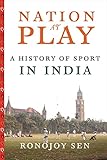Nation at Play : A History of Sport in India / Ronojoy Sen.
Material type: TextSeries: Contemporary Asia in the WorldPublisher: New York, NY : Columbia University Press, [2015]Copyright date: 2015Description: 1 online resource (400 p.) : 24 b&w photographsContent type:
TextSeries: Contemporary Asia in the WorldPublisher: New York, NY : Columbia University Press, [2015]Copyright date: 2015Description: 1 online resource (400 p.) : 24 b&w photographsContent type: - 9780231164900
- 9780231539937
- 796.0954 23
- GV653 .S46 2016
- online - DeGruyter
| Item type | Current library | Call number | URL | Status | Notes | Barcode | |
|---|---|---|---|---|---|---|---|
 eBook
eBook
|
Biblioteca "Angelicum" Pont. Univ. S.Tommaso d'Aquino Nuvola online | online - DeGruyter (Browse shelf(Opens below)) | Online access | Not for loan (Accesso limitato) | Accesso per gli utenti autorizzati / Access for authorized users | (dgr)9780231539937 |
Browsing Biblioteca "Angelicum" Pont. Univ. S.Tommaso d'Aquino shelves, Shelving location: Nuvola online Close shelf browser (Hides shelf browser)

|

|

|

|

|

|

|
||
| online - DeGruyter Algerian Imprints : Ethical Space in the Work of Assia Djebar and Hélène Cixous / | online - DeGruyter Doing Aesthetics with Arendt : How to See Things / | online - DeGruyter Eqbal Ahmad : Critical Outsider in a Turbulent Age / | online - DeGruyter Nation at Play : A History of Sport in India / | online - DeGruyter FDA in the Twenty-First Century : The Challenges of Regulating Drugs and New Technologies / | online - DeGruyter Pope Francis Among the Wolves : The Inside Story of a Revolution / | online - DeGruyter The Ethnic Avant-Garde : Minority Cultures and World Revolution / |
Frontmatter -- Contents -- Acknowledgments -- Introduction -- 1. Down the Ages: Sport in Ancient and Medieval India -- 2 . Empire of Sport: The Early British Impact on Recreation -- 3 . White Man’s Burden: Teachers, Missionaries, and Administrators -- 4 . Players and Patrons -- 5 . The Empire Strikes Back -- 6 . Politics on the Maidan -- 7 . The Early Olympics -- 8 . Lords of the Ring -- 9 . Freedom Games -- 10 . Domestic Sports -- 11 . 1971 and After -- 12 . Life Beyond Cricket -- Notes -- Index
restricted access online access with authorization star
http://purl.org/coar/access_right/c_16ec
Reaching as far back as ancient times, Ronojoy Sen pairs a novel history of India's engagement with sport and a probing analysis of its cultural and political development under monarchy and colonialism, and as an independent nation. Some sports that originated in India have fallen out of favor, while others, such as cricket, have been adopted and made wholly India's own. Sen's innovative project casts sport less as a natural expression of human competition than as an instructive practice reflecting a unique play with power, morality, aesthetics, identity, and money.Sen follows the transformation of sport from an elite, kingly pastime to a national obsession tied to colonialism, nationalism, and free market liberalization. He pays special attention to two modern phenomena: the dominance of cricket in the Indian consciousness and the chronic failure of a billion-strong nation to compete successfully in international sporting competitions, such as the Olympics. Innovatively incorporating examples from popular media and other unconventional sources, Sen not only captures the political nature of sport in India but also reveals the patterns of patronage, clientage, and institutionalization that have bound this diverse nation together for centuries.
Mode of access: Internet via World Wide Web.
In English.
Description based on online resource; title from PDF title page (publisher's Web site, viewed 20. Nov 2024)


